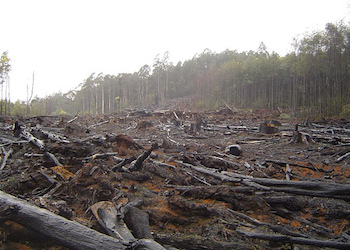A new report says deforestation in Colombia increased considerably in 2016, with over a third of deforestation occurring in FARC concentration zones created as part of the country’s historic peace process, raising questions about the environmental impacts of the guerrilla demobilization.
A total of 178,597 hectares of land were deforested in Colombia in 2016, according to a new report from Colombia’s Hydrology, Meteorology and Environmental Studies Institute (Instituto de Hidrología, Meteorología y Estudios Ambientales – IDEAM). This figure represents a 44 percent increase from the 124,035 hectares of land deforested in 2015.
Notably, 37.7 percent of deforestation was concentrated in the 27 municipalities where the concentration zones (Zonas Veredales Transitorias de Normalización – ZVTN) for the Revolutionary Armed Forces of Colombia (Fuerzas Armadas Revolucionarias de Colombia – FARC) are located, El Tiempo reported. As part of the peace process, demobilizing guerrilla fighters temporarily moved to these zones to hand over their weapons and begin the transition to civilian life.
Among the primary causes of the increased deforestation were illicit crop cultivation, infrastructure development, forest fires, extensive livestock breeding and illegal mining, according to the report.
Colombia’s Amazon region continued to have the largest amount of deforested area, accounting for 39 percent of the total damage in 2016. The Pacific region, however, had the greatest increase in deforested area, up from 10 percent in 2015 to 16 percent in 2016, the report found.
At least one hectare of deforestation was recorded in 65 percent of Colombia’s municipalities in 2016.
InSight Crime Analysis
Increased deforestation is a worrying sign for Colombia as other challenges to the peace process loom. InSight Crime has previously identified that the majority of FARC concentration zones were located in municipalities at “high risk of a recycling of criminal violence and economies.” This new report shows that this dynamic could be accompanied by adverse environmental effects.
During a recent field investigation in the department of Meta, one FARC commander told InSight Crime that deforestation has increased considerably since the ex-guerrillas arrived in Vista Hermosa municipality.
SEE ALSO: Colombia News and Profiles
However, the deforestation had more to do with the FARC’s departure from areas under their control rather than their arrival in concentration zones. While the FARC previously exercised control in Meta department, local residents told InSight Crime that people have taken advantage of the FARC’s absence. Increased livestock breeding has primarily contributed to the increase in deforestation, they said, while increased coca cultivation has had a secondary effect.
“Around 1,500 hectares [have been deforested] due to cattle breeders from other regions who have a lot of money and links with criminal groups,” Commander Byron Yepes of the FARC’s 27th Front told InSight Crime in Vista Hermosa municipality.
Increased illegal mining and logging in Putumayo department and along Colombia’s pacific coast, as well as increased coca cultivation in Norte de Santander, have also caused increased deforestation in areas where the FARC’s concentration zones are located, according to InSight Crime field research.

